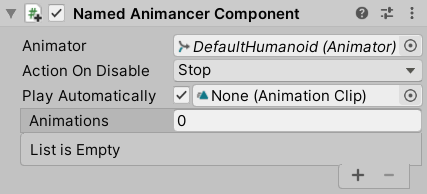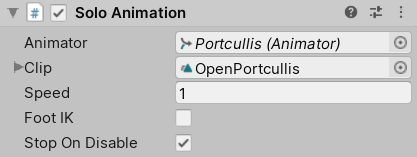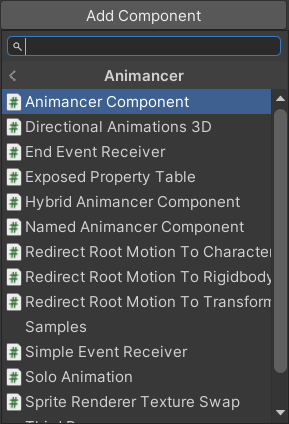The AnimancerComponent is the main entry point for controlling animations with Animancer. It also has several sub-classes with additional functionality:

Animancer Component
AnimancerComponent is the base class with all the core functionality.
Sample: Quick Play (and most others)
The base component which wraps the core functionality of Animancer.
The Animator field references the Animator component that Animancer will control.
The Action On Disable field determines which DisableAction will be used when the object is disabled.

Named Animancer Component
NamedAnimancerComponent registers animations by name so that you can use TryPlay("Animation Name").
Sample: Named Character
Inherits from AnimancerComponent.
Overrides the GetKey method to use the animation name so that you can use TryPlay("Animation Name"). See the Keys section for more information.
The Animations array allows you to pre-register AnimationClips (so you can TryPlay them by name like in Unity's Legacy Animation component).
The Play Automatically toggle determines if you want it to play the first animation in the list on startup.

Hybrid Animancer Component
HybridAnimancerComponent allows you to implement a Hybrid combination of an Animator Controller and Animancer where each system works alongside the other.
Sample: Hybrid Character
Inherits from NamedAnimancerComponent.
Pro-Only: Animancer Lite allows you to try out this feature in the Unity Editor, but it will not be available in runtime builds unless you purchase Animancer Pro. See the Feature Comparison for more information.

Solo Animation
SoloAnimation plays one animation.
Sample: Doors
Plays one animation which can be assigned in the Inspector without the performance overhead of the rest of Animancer.
That's all it does. It doesn't support Fading or Layers or Animancer Events or any of the other features of Animancer. It is not even really part of Animancer, it is just a self-contained script designed to play that one animation and nothing else. If you want to do anything more than that you're likely better off using a proper AnimancerComponent.

Adding Components
When using the Add Component menu in the Unity Editor, all of Animancer's components are located in the Animancer sub-menu.
Source Code
The scripts containing these components are located in the Packages\Animancer\Runtime folder and they are even included in Animancer Lite, so you can modify or Inherit from them to implement your own variations. For example, you could:
- Inherit from
AnimancerComponentand add aSpriteRendererorSkinnedMeshRendererfield so you can reference it alongside the animations. - Make a
CharacterAnimationSetclass which inherits fromScriptableObjectto define a set of animations for each character and then make aCharacterAnimancerclass which inherits fromAnimancerComponentto allow a character to reference one of those animation sets in the same place as the rest of the animation functionality. - Inherit from
NamedAnimancerComponentand add an array ofstrings so that you can specify a custom name for each animation rather than always using the exactAnimationClip.name. - Inherit from
AnimancerComponentand add someAnimationEventReceivers to listen for certain Animation Events.